Hannah's Blog
Age: 21
University: Bangor University
Studying/Course: German and Spanish
Languages: English, German, Spanish
Hannah's posts are shown below. Click one to read it...
A hearty hello to all!
On today's blog post I shall be talking about health and fitness here in sunny Spain!
I think we can all agree that your health is important and that you have to look after yourself through having a balanced diet and getting plenty of exercise (something I'm sure you've heard hundreds of times before). So how do you go about that when the foods and environment are completely different?
One thing that I have found from living in Alicante is that fruit and veg are everywhere! Out and about I've seen lemon trees (yes, really!), avocado trees and mandarin trees aplenty! They are readily available if you go into the markets or supermarkets and very affordable!

(sunshineandsiestas.com)
There are also different types of vegetables that I haven't seen before coming here such as the Romanesco cauliflower (which tastes similar to what we know as an ordinary cauliflower and actually comes from Italy) – pictured below.

(albertgascon.com)
You can find artichokes ("alcachofas" in Spanish) here too which to me look like giant asparagus (image below). It's somewhat difficult to describe the flavour of an artichoke – but believe me, when cooked with spices it is delicious! And an excellent way to get one of your five a day!

(sunshineandsiestas.com)
I have found that from going round the local supermarkets here, fruit and veg are definitely an affordable staple and the unhealthier things such as fizzy drinks, cake and crisps etc. bump the price up. This I have found to really encourage me to eat healthier and I think that it is a fantastic idea that we should perhaps apply in the UK. It's nice to have a treat every now and again but with these costing more, it does become a treat and not a habit.
Following the same theme of food in supermarkets, there are a LOT more foods available to those that need to be dairy free or gluten free and here they are so much more affordable. Many things are even in with regular food and taste just as good that you might not even notice the difference – but the difference is apparent for those who have come from the UK or elsewhere that don't have quite as many choices as here.
It is also incredibly important to drink plenty here; they say you should have 8 glasses of water a day, but I think on hot days you should be drinking more than that! When I first arrived here at the end of August the average temperature was about 35°C! That's very hot! And I was going through several litres of water a day! Even now, in December, as I am writing this, warm days are about 19°C which feels warm as the sun is low in the sky. It's a very different atmosphere from the frost and even snow that we are used to in December.
With that, exercise does become more difficult. It's difficult to enjoy a morning jog or an evening work out when the air is so humid that you find it difficult to breathe. During the summer even the nights were very warm and so it was difficult to be motivated to keep active. It is, however, essential to a healthy lifestyle and even if I wasn't running I took my 2 litre bottle of water and went for a long walk; living in Alicante there are so many places that you can discover by walking be they cute back streets or mountain views. It is much easier to keep active at this time of year as the nights are about 12°C which is much more bearable!

This was the view from part way up the Calpe rock (not too far from Alicante) and I think you can agree that the walk was worth it! (Even if it does make you a little red in the face)

Sometimes a walk along the beach can be just what is needed to cool down after a long day and what better way to see the sunset over the horizon than surrounded by the sound of the waves and the beauty of the palm trees?

The island that can be seen here is the isle of Tabarca, just an hour's boat ride from Alicante.
If the sand isn't quite your thing, a walk up to the castle surrounded by beautiful landscapes and a chance to discover the history and culture of the city can be just what is needed.

Just don't forget your bottle of water! Even in December it's T-shirt weather!)
And if walking is boring to you or you'd rather try a different type of exercise there are so many to choose from! There are volleyball nets set up on the beach or you can hire a bike from most places where you just pay a small deposit. The scheme in the town where I am living is highly successful and it's quite  common to see students on bicycles with the San Vicente logo on them. (Universidad de Alicante website)
common to see students on bicycles with the San Vicente logo on them. (Universidad de Alicante website)
For me, the only downside of this scheme is that there is nowhere to rent a helmet and I definitely think it is wise to always wear a helmet when you are riding a bike! In most places the pavements are wider and there is a portion of the pavement dedicated to a cycle lane and I've seen people on rollerblades come skating down this path too! I think this is much safer than having to be on the road next to the cars.
If all this doesn't sound exciting enough you can also take dance lessons in Alicante and one of the most popular types of dance that my Spanish friends have introduced me to is the art of salsa. This is something that you can see many, many people dancing to if you go to the "discotecas" in town. The music they dance to is different than what you would find in the UK and lends itself very nicely to salsa. Salsa makes you use your whole body to dance instead of just your feet and so is a great way to get your heart rate up and exercise many different parts of the body.
I hope I've given you something to think about here and some insight into the health and fitness side of living in Alicante, Spain.
Thank you for reading! Until next time amigos!
¡Hola a todos!
This shall be the last post I write from Spain, as my adventure here is unfortunately slowly coming to an end, however I shall then be writing to you from Germany! In this post, I'll be discussing festivals and celebrations here in Spain.
Throughout my time in Spain I have experienced many different festivals, some of which I will explain and describe for you. Some of these are huge festivals with music and dancing and others are smaller celebrations.
The first one that I am going to talk about is one of the biggest that I have experienced – la fiesta de San Juan (the festival of San Juan). I happened to be in Spain on the 23rd of June last year when I was doing an intensive course in Galicia and experienced the festival. It was one of the biggest things I have ever seen; there were bonfires in every square and all along the beaches, and this was before any of the festivities even began! In the evening, we wrote our wishes on a piece of paper and put them into the big bonfire which would be later that night. The festival centres itself around the summer solstice and supposedly rids the towns of evil spirits and witches. There was a procession in the middle of town of people wearing masks of wolves and "demons" and witches et cetera carrying flaming torches, cauldrons of smoke and various musical instruments.

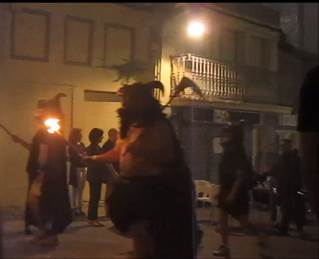
There was such a lot to see, including people walking through the streets with bagpipes and other musical instruments. At the same time as this, there were fireworks going off all around the city so there were plenty of things to catch your attention!
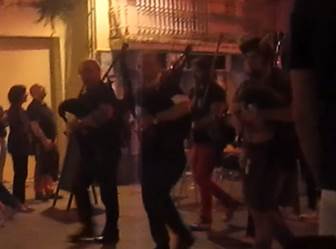
After the procession, people made their way down to the nearest square where there was a huge bonfire (bigger than any that I've ever seen on November the 5th celebrations) where a stuffed "man" was placed – the very same one where we put our written down hopes, as you will be able to see in the following picture.

The crowds were huge and people were about ten deep! There were stalls selling nuts and seeds to munch on and confectionary for those with a sweet tooth, and so much more. Everywhere you turned there was something different; even a magician doing magic tricks while we waited for the fire to be lit and the celebrations to start.
When the fire was lit, it took very quickly due to all the paper with peoples hopes and wishes being in there, and to our (well, mostly my) surprise more fireworks were set off! When the fire had died down a little bit, some of the glowing embers were shovelled into smaller piles around the square which people were jumping over as it is thought that this brings luck for the coming year. After this was some traditional dancing which was so fun, even if like me you have two left feet.
The next celebration that I would like to talk about is birthdays. In Spain birthdays are celebrated slightly differently than in the UK. The first thing that is massively different is the type of cake; we're used to sponge cake which is typically a Victoria sponge with icing or chocolate with more chocolate, however in Spain it's made of layers that sometimes have sponge in them but also are more like a mousse type consistency, like the picture below (I can assure you that it tastes much better than I am able to describe).
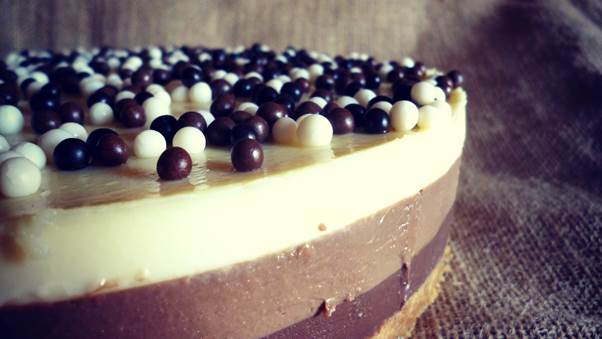
(yourspanishrecipes.blogspot.com.es)
As far as I can tell, the rest of the birthday traditions are similar, such as when younger playing "pin the tail on the donkey". A way that is different is that some, not all, celebrate their name day as well as their birthday though not to the same extent as a birthday. A name day is the day a celebratory meal is had to celebrate the saint who the person was named after, for example, someone named Jorge (George in English) would celebrate their name day on the 23rd of April.
The next celebration I'd like to tell you about is Christmas. Now although many people in Spain, especially our generation, don't go to mass every Sunday or follow all the rules of the bible, Spain is a Roman Catholic country and therefore Christmas is traditionally celebrated in a religious way. This might involve going to midnight mass and a church service on Christmas morning, though this is the same in many countries for those that follow the Christian faith.
Decorations in the home are different, for example most homes feature a miniature "Belén" (a nativity scene) typically made of porcelain and although many homes do have a Christmas tree, it is usually not put up until closer to Christmas rather than at the beginning of December as many do in the UK.
Christmas is spread over several days rather than one big event like in the UK, and some days are national holidays meaning no work and no school.
On the 8th of December is the celebration of the "Immaculada" (the Feast of the Immaculate Conception – where the bible tells Mary finds out that she is to expect a baby).
On the 21st of December, some places celebrate the Winter solstice in a similar way to the festival of San Juan but on a smaller scale by jumping over smaller fires in a hope to avoid illness over the winter.
On the 22nd of December although not a national holiday, it is one of great importance for the Spanish people as it is the day that the Christmas Lottery is drawn. This is similar to the national lottery in the UK but almost every person in Spain buys a ticket and the prizes are huge.
On the 24th of December, Nochebuena (or Christmas Eve as we call it) is the main day for family celebrations. It is quite common for friends to meet during the day to have a small celebration but the big celebration for family is held in the evening with a huge amount of food to accompany it. A small gift may be given on this day but it is mostly about being with family. The food typically consists of prawns to start, roasted lamb for main and turrón as a dessert/sweet (turrón is a nougat made with sweet almonds, and trust me, sickly if you eat too much). This day is not a national holiday though in the past it has been.
On the 25th of December, it is a calm day after eating so much food and is a national holiday so shops are closed though some restaurants may open. It is a day to spend the day as a family and go for a walk or play board games etc.
On the 31st of December, it is a big celebration for Nochevieja (New Year's Eve) where there are street parties and all manner of festivities. People tend to stay at home until midnight, as it is tradition on the stroke of midnight to eat grapes – 12 in total, one for every strike of the clock. This is thought to bring luck for the new year. Then many people go out to celebrate the new year.
The 1st of January is a national holiday where people tend to stay at home after the late night from the night before. They may do things such as go for family walks or just watch the television.
On the 5th of January, there are processions with floats depicting the arrival of The Three Kings or Wise Men. Sweets may be thrown from the floats to the crowds where there are typically large turnouts.
The 6th of January is the main event for the Spanish. The Día de los Reyes Magos (The Day of the Three Kings or Epiphany as we call it) is where children wake up to find the three kings have left them presents (Father Christmas or Santa Claus may leave a small present on the 25th of December, but the 6th of January is when the main thing happens). The day after, the celebrations are considered over and everyone returns to work and school if it is a week day.
There are, of course, many more festivities and celebrations in Spain, however I could be writing to you all day about them. These are just a few of my favourites.
Thank you for reading, and I look forward to speaking to you from Germany!
Until next time amigos!
Guten Tag!
It is with great pleasure that I shall now be writing to you from Mainz, Germany! Today I shall be discussing national holidays and local areas of interest.
I feel very lucky to be able to talk to you about Easter, one of my personal favourite holidays. It is a holiday that I would usually associate with spending time with family, like Christmas, but this year I was in Germany for Easter and this was so exciting for me!
Germany, much like Spain, focuses on the religious side of the holiday rather than just the chocolate which I think is a nice thing (although please don't misunderstand me, the chocolate does feature quite prominently).
The days in the run up to Easter were very busy in the town, particularly in the supermarkets as people were preparing for feeding their families and buying sweet treats for their young ones. In Germany, you can buy white eggs which are much better for painting and decorating as you can see in my photo below (and they practically flew off the shelves) and this would be done in the run up to Easter Sunday.
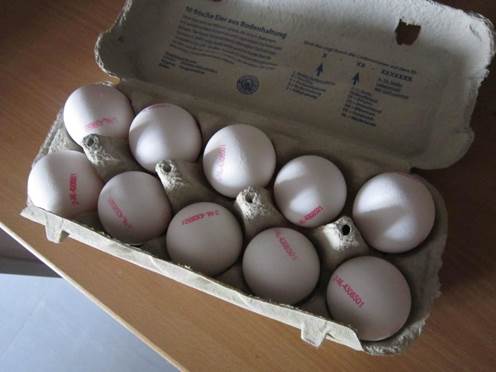
However, Sunday is not the only day that is celebrated. The festivities begin on Maundy Thursday (the Thursday directly before Easter Sunday) and in German is known as "Gründonnerstag". The word actually comes from the older German word "greinen" which means to cry or mourn, but because it looks a lot like "grün" (or green in English) it has become a new tradition to eat green food on this day.
The next day that is celebrated is Good Friday, or in German "Karfreitag" where families have a meal together which is typically fish as many people (though not all) in Germany are catholic and this follows the catholic tradition.
n comes many people's favourite part, Easter Sunday or in German "Ostersonntag" when Easter eggs are exchanged. If you are Christian it is normal to go to a church or cathedral on this day and receive a blessing for this day; it is a day when Christ ascended to heaven and so we give thanks that God gave his son to abolish our sins. The cathedral was so full that there was no room left for people to sit (and I would say that the cathedral sat around a thousand people or maybe more) so there were lots of people stood around the side of the cathedral for the whole service! After church, it is tradition to have a huge meal with the family, like at Christmas, but the main dish is traditionally lamb as it represents innocence and the spring.
The day after Easter Sunday is often known as Easter Monday or in German "Ostermontag" and in many places, it is treated the same as Easter Sunday. Shops and supermarkets stay closed though some cafes and restaurants do open.
I shall now tell you a little about the city of Mainz. It is very difficult for me to choose a place of interest as there are so many fascinating parts to this wonderful city. As you may know, Germany is divided into states similar to the USA, however Germany's states are much smaller. Mainz is located in the state of Rheinland-Pfalz and is the capital of this state. Mainz is famous for being the birthplace of the movable printing press in the early 1450s (so a very, VERY long time ago!). This was invented by a man named Gutenberg, of whom there is a statue in the centre of the city, as shown by my photo below.
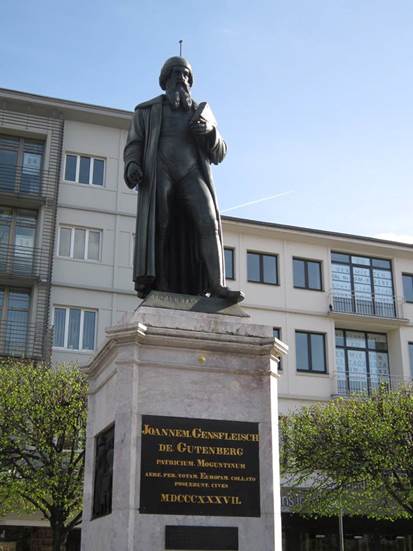
Also of interest, particularly for anyone that is interested in the architecture of buildings, there is the cathedral which is one of the most beautiful buildings I think I have ever seen. It was built in several stages over hundreds of years so each part consists of architecture typical to the era in which it was built. Building on the earliest part of the cathedral commenced in 975AD, meaning that this part of the cathedral is over a thousand years old! At first I thought it looked like a red version of Hogwarts, but you can make your own minds up on that one. Below are two photos that I took at different angles and different times. The shops that are in front of the cathedral were built long after the cathedral but were built in keeping with the style and structure, so as not to detract from the cathedral itself. There is a weather vane at the top of one of the turrets and there is a legend in Mainz that says that if the rooster is facing the river (the Rhine) then the weather will be nice. This next photo is all the proof you need that the rumours are true!
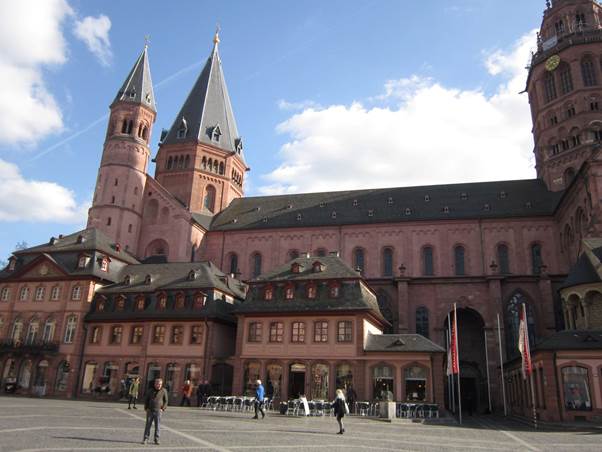

One of my favourite things in the city is the fountain of the "Fastnachtsbrunnen" which depicts the little fairy type creatures of "Fastnacht" which is the carnival. It is called the fasting night because it takes place before Ash Wednesday, a night of fasting. There are many different figures on the fountain, all of which are supposed to show the happiness of fools and that throughout everything happiness is the one thing that remains stable. Here is a photo that I took.

Something else that I found to be interesting are the street signs. They are a mixture of red and blue and if the street signs are red they point towards the Rhine and if they are blue they run parallel to the Rhine. This is a very helpful tip for when you are lost as I have been many times. It helps you work out where you are and where a good point of reference is.
I hope that you can see what a fascinating place I am living in and that you have found out something new and interesting. It is definitely a place worth visiting and I can't wait to start my studies here and discover even more things about the city.
Until next time!
Mit freundlichen Grüßen!
School system in Germany
Today I shall be discussing school and college studies. The school system is slightly different in Germany so I decided to make a table to compare it with the British system to show you.
Age |
In [most schools in] Britain |
In Germany |
3 - 5 years |
Nursery |
Kindergarten |
5 – 6 years |
Primary Year 1 |
Grundschule Grade 1 |
6 - 7 years |
Primary Year 2 |
Grundschule Grade 2 |
7 – 8 years |
Primary Year 3 |
Grundschule Grade 3 |
8 – 9 years |
Primary Year 4 |
Grundschule Grade 4 |
9 – 10 years |
Primary Year 5 |
Orientation Stage Grade 5 |
10 – 11 years |
Primary Year 6 |
Orientation Stage Grade 6 |
11 – 12 years |
High School Year 7 |
Hauptschule/Realschule/Gymnasium/ Gesamtschule Grade 7 |
12 – 13 years |
High School Year 8 |
Hauptschule/Realschule/Gymnasium/ Gesamtschule Grade 8 |
13 – 14 years |
High School Year 9 |
Hauptschule/Realschule/Gymnasium/ Gesamtschule Grade 9 |
14 – 15 years |
High School Year 10 |
Hauptschule/Realschule/Gymnasium/ Gesamtschule Grade 10 |
15 – 16 years |
High School Year 11 |
Vocational Training |
16 – 17 years |
6th Form College Year 12 |
Abitur |
17 – 18 years |
6th Form College Year 13 |
Abitur |
18 – 19 years |
University |
Abitur (some go to university in this year, depending on how their version of 6th form works) |
19 – 20 years |
University |
University |
As you can see, there are some big differences and some very small differences between the British and the German systems. The main difference, I think must be what they call the different schools after primary school.
- The Hauptschule tends to be for students that are more vocationally minded, so the students that are more likely to go on to do an apprenticeship after high school.
- The Realschule is the most popular type of high school in Germany. This type of school tends to be for the academically minded and is often thought to be just a slight step down from the "Gymnasium". That said, they typically receive better academic results than most average British schools.
- The Gymnasium is seen as being the highest class of secondary education. Traditionally in the Gymnasium, students studied Greek and Latin alongside the other traditional subjects like maths and science but this has become less common now. At the end of studies at the Gymnasium students graduate with an "Abitur" diploma which more or less guarantees entrance to university, though not necessarily onto the course they want.
- The Gesamtschule is the school most like British schools. It provides a combination of all three previously mentioned schools into one comprehensive school.

picture from clipart)
In many schools in Germany they only attend class until about 1pm; however cool this sounds, they do start very early in the morning. The days are still usually shorter than the typical school day in the UK. Ganztagsschule (literally "whole day schools") are becoming more popular these days due to parents working and not feeling comfortable with their children home alone all afternoon. In these types of schools, they occasionally have study periods alongside their classes so that they have time to do their homework as well as their extracurricular activities like sport etc. These, however, are not usually offered at school but rather in the local community.
Although not very common in the UK, home schooling is actually illegal in Germany. People have tried to repeal it many times but it still remains law that every child must attend an approved school.
Something else that surprised me about going to university here in Germany is that they knock on the tables after the class has finished; I don't think that they do this in high schools but it is certainly a big politeness thing here in classes and lectures at university and in meetings. It's a lot less harsh than clapping and sometimes clapping can be seen as rude in these contexts – though at non-academic performances it is quite normal to clap, like if you go to see a play or something.

Knocking on the table (picture from clipart)
Lessons in Germany are generally about 45 minutes long in primary schools and 90 minutes long in high schools with a 5-10-minute break between each class to get to the next lesson on your timetable.
Languages are a compulsory part of education in every type of school; every school requires you to study at least five years of English or French and in the "Gymnasium" it is compulsory that students learn at least two foreign languages, though in the "Gymnasium" there is more choice about which language you study. The interesting part about foreign language classes is that they are mostly taught in the language that you are learning, which I can tell you from experience really helps with learning the language, although I'll be honest it can be slightly confusing at first. It does however improve listening and comprehension skills, so it can't be all bad!
In the UK, most teachers write on whiteboards with washable markers but here in Germany they write on dark green boards with chalk. This is quite cool, particularly for those that have trouble reading black on white. Sometimes it is difficult to read the chalk however, as they don't always use white chalk and when writing in blue or orange it can sometimes make things more confusing. They also use overhead projectors here (as seen in the picture below) something that I personally haven't seen for about ten years or so.
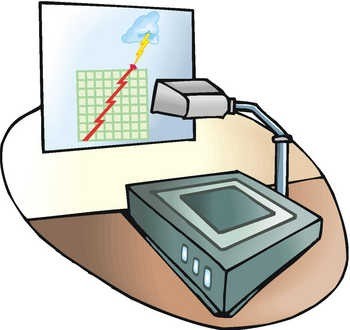
verhead projector
(picture courtesy of wordpress.com)
That said, if something works there is no point changing it and since this has been working there is no reason to change it. They do of course use the LCD projectors that are often fixed to the ceiling too.
Another big difference between Germany and the UK is that in most schools in Germany they don't wear a uniform. It's mostly just the private grammar schools that require students to wear a uniform. There are of course schools in the UK where students don't wear uniforms, but in most cases, we do.
Thanks for reading, and I hope you learned as many interesting things as I have.
Until next time!
Mit freundlichen Grüßen!